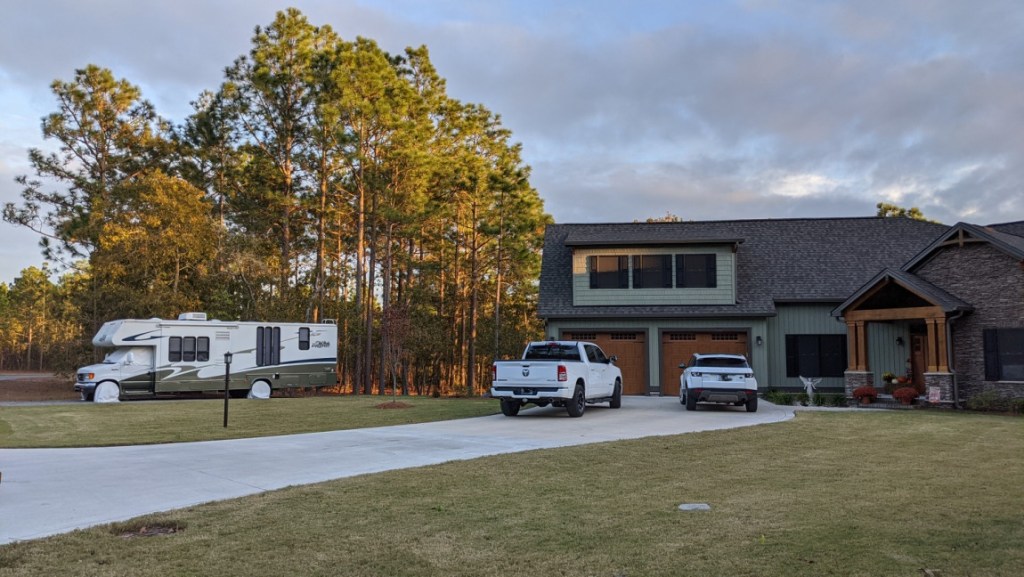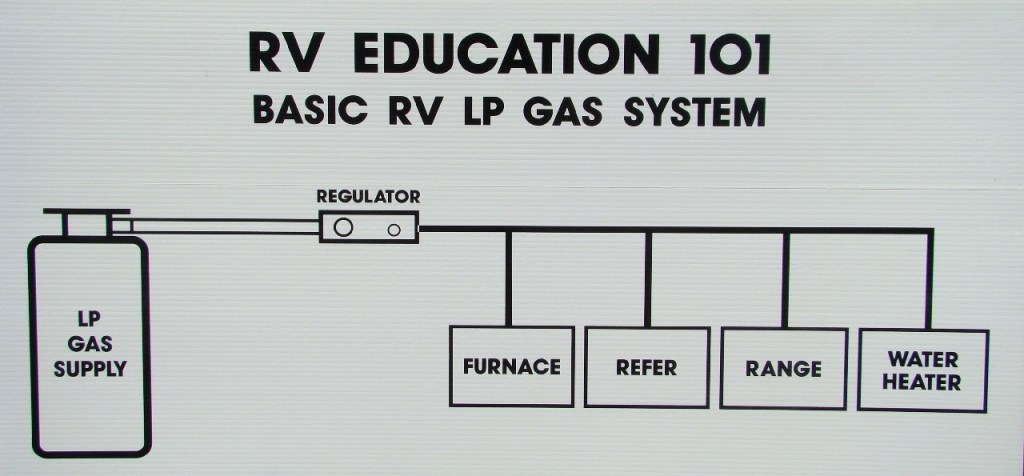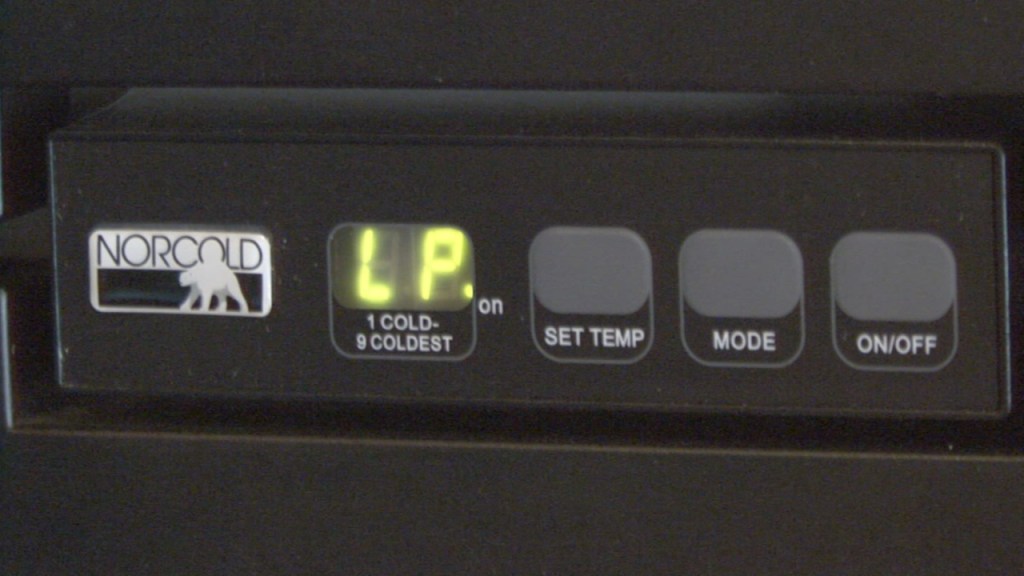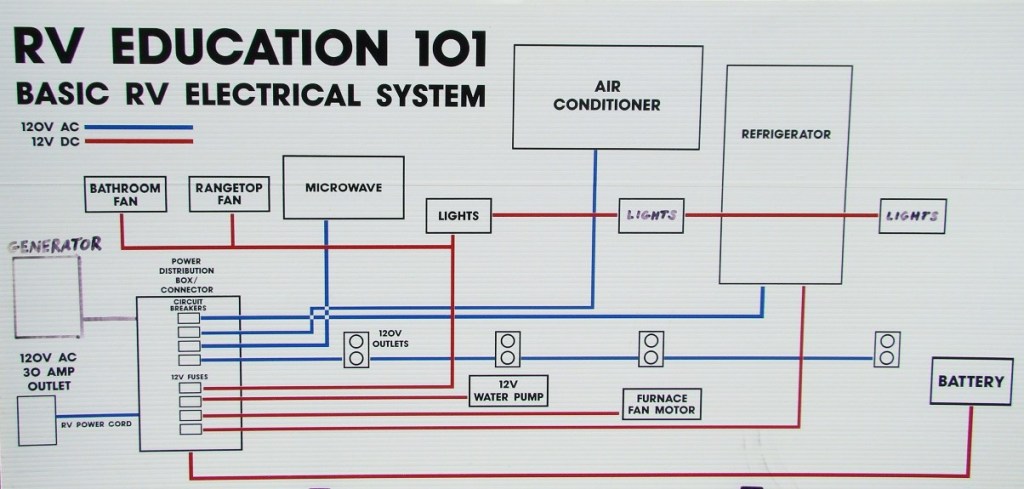
RV Newbie – You just bought an RV now what?
You researched it, found a reputable RV dealer, ordered it, waited for it and the big day finally arrived, the day you get to bring your new RV home. The excitement and anticipation is overwhelming, then suddenly there it is sitting in the driveway. What do you do now? Before you jump in and head out on a cross-country RV trip, let’s think about this for a minute. You want the first trip in your new RV to be awesome, not troublesome so let’s start by making sure both you and the RV are ready to go.
The dealership you purchased the RV from is required to perform what is known in the industry as a Pre-Delivery Inspection, or PDI, on the RV prior to you taking delivery of the unit. A PDI is a safety and operational check to make sure all of the systems and appliances are operating properly, so your new RV is ready to go camping. These PDIs are quite thorough and for the most part technicians will catch and repair any deficiencies noted during the inspection. With that said, RVs are very complex, with wiring and plumbing systems routed through the RV’s walls, roof and undercarriage. So it is possible for potential problems to be missed or overlooked during the PDI process.
The RV Newbie Shakedown Trip
I always recommend taking a short, close to home RV shakedown trip prior to venturing off on a longer RV trip. When I say close to home it can be as close as your backyard, or a campground near where you live. All you really need is access to water and electricity to give the new RV a good once-over.
RV 101® *Note: Some RV dealers let you spend a night or two camping at the dealership before taking the RV home. They connect the RV to a water and electrical source and you get to test the unit, making sure everything operates properly.
Regardless of where the shakedown trip takes place it serves several purposes:
1) A shakedown trip helps you identify any problems, and make repairs while you are still close to home. It is much easier to have your RV dealer make repairs than it is to find a repair facility willing to work on the RV when you are traveling. Keep a pen and paper close at hand and write down whatever deficiencies you find so repairs can be made.
2) A shakedown trip lets you know what you forgot to pack, so you don’t forget it when it’s time for that two-month cross-country RV trip. Again, keep a pen and paper close at hand and write down whatever comes to mind in the way of personal belongings and supplies you can’t live without when you go camping.
3) A shakedown trip gives you an opportunity to try all of the onboard systems and familiarize yourself with how things work on the RV. I also recommend you enroll in an RV training course specific to the type you of RV you purchase to assist in learning how to use your new RV. The more you know about the RV the more enjoyable your RV experiences are.
4) If you find any shortcomings during the shakedown trip schedule an appointment with the dealership to have the repairs made. When you take the RV in for repairs go over all your concerns with the service writer. Point everything out on the RV so they understand exactly what you are talking about and they can expedite the repairs.
What do you check during the RV shakedown trip?
Every RV manufactured has what I refer to as the 3 primary systems of an RV, the LP gas system, the RV water & wastewater system and the RV electrical system. You need to go through all the systems on your RV to ensure everything is operating properly before you plan and take a long RV trip. We cover all these systems thoroughly in our RV online training courses, so you know exactly what to look for during your shakedown trip.
The LP Gas System

As part of the PDI, the dealership is required to check (and adjust if necessary) the LP gas operating pressure and perform a leak test. You can rest assured the LP gas system is safe to use when you take delivery, so you can familiarize yourself with the operation of all the LP gas appliances in the RV. Start by making sure the LP gas is turned on at the tank or cylinders. LP gas appliances in RVs include the water heater, the refrigerator in the LP gas mode, the range burners and oven and the furnace.

When you connect a potable water source to the RV, open a hot water faucet at the sink and when you get a steady flow of water (no spitting or sputtering) the water heater tank is full.

To test the refrigerator place the selector on the control panel in the LP gas mode. The burner should light, and the refrigerator should start cooling (this can take 4 to 6 hours for maximum cooling). If it does not light, a check light will illuminate on the refrigerator led panel and you need to try lighting it again.
RV 101® *Note: The RV needs to have a battery, or be plugged into electricity for the refrigerator to operate in the LP gas mode.
Check out our RV video training courses at RV Online Training to see how all the LP gas appliances and system operates.
RV Water & Wastewater System

RV have two water systems. It has a fresh water holding tank that uses a 12-volt water pump to pump pressurized water throughout the plumbing system. And it has a city water connection to connect directly to a potable water source using a drinking water hose. As part of the PDI technicians test the water system for leaks and proper operation.
Connect a drinking water hose to a potable water source and connect the other end to the city water connection on the RV. Turn the water on and test the operation at the sinks, shower or tub, toilet and water heater. Water from the sinks and shower drain into a gray water holding tank. The toilet wastewater goes into the black water holding tank. There is a monitor panel inside the RV so you know how much is in the holding tanks. When the holding tanks are full you empty them into the campground sewer system, or an approved dump station using a sewer drain hose and sewer hose adapters.
Check out our RV video training courses at RV Online Training to see how the RV potable water and wastewater systems operate.
The RV Electrical System

Your RV has a 12-volt and 120-volt electrical system. If the RV is not plugged into a 120-volt source you need a deep-cycle battery to use the 12-volt items highlighted in red above. If the RV is plugged into a proper electrical source (30-amp or 50-amp depending on your RV) you can use everything highlighted in red and blue above. Test the electrical system to make sure everything in the system works properly.
RV 101® *Note: If you are plugged into a 20-amp household outlet you are limited in what you can use. Do not operate the air conditioner, or any two 120-volt appliances at the same time when the RV is connected to a 20-amp outlet. Better safe than sorry.
Check out our video training courses at RV Online Training to see how the 12-volt and 120-volt electrical systems operate.
Miscellaneous Items
During the shakedown trip keep an eye out for anything obvious like a water leak or a light that does not work. If there is a water leak that is significant turn the water source off and open a faucet to release the pressure. Do not use the water system until the leak is repaired.
Look for other shortcomings and simple items like a cabinet or drawer that needs to be adjusted. Keep a pen and paper close by so you can make notes about repairs that need to be accomplished. If you don’t write everything down you won’t remember what to tell the service writer when you take the RV in to be repaired.
The RV is covered by a factory warranty when it is new, and/or you may have purchased an extended service contract. Some items on the RV, like a cabinet or drawer not adjusted properly are covered for a shorter time period. Try to identify items like this within the first 30 to 90 days to have repairs made.
RV 101® * Note: Go through the RV owner’s manual packet thoroughly and fill out all the manufacturer warranty cards you can locate. Items like the TV, microwave etc. have there own manufacturer warranty that usually exceeds the factory RV warranty time period.
To learn more about your RV prior to your first RV trip visit RV Online Training and check out our selection of RV video and RV e-book training courses.
After your shakedown trip take the RV back to the RV dealer for repairs, and then the only thing left to do is plan your first trip, load it up, hook it up, fuel it up and go have fun.
Happy Camping,
Mark J. Polk
RV 101® Travel Trailer Ultimate Video & E-book Bundle
https://rvonlinetraining.com/p/travel-trailer-ultimate-e-book-and-video-bundle
RV 101® 5th Wheel Ultimate Video & E-book Bundle
https://rvonlinetraining.com/p/rv-101-5th-wheel-ultimate-video-e-book-bundle
RV 101® Motorhome Ultimate Video & E-book Bundle
https://rvonlinetraining.com/p/rv-101-motorhome-ultimate-video-e-book-bundle
Travel Trailer & 5th Wheel Trailer RV Orientation Video Training Course
https://rvonlinetraining.com/p/rv-101-rv-orientation-for-travel-trailer-s-5th-wheel-trailers
Tow Your Travel Trailer Like a Pro Video Training Course
https://rvonlinetraining.com/p/rv-101-trailer-towing-basics
Tow Your 5th Wheel Like a Pro Complete Online Video Training Course
https://rvonlinetraining.com/p/tow-your-5th-wheel-like-a-pro
Motorhome RV Orientation Video Training Course
https://rvonlinetraining.com/p/motorhome-rv-orientation-video-training-course
Drive Your Motorhome Like A Pro Complete Online Video Training Course
https://rvonlinetraining.com/p/drive-your-motorhome-like-a-pro
RV Care & Preventive Maintenance RV DIY® Online Video Training
https://rvonlinetraining.com/p/rv-101-rv-care-preventive-maintenance-online-video-training
RV Essential Items Video Training Course
https://rvonlinetraining.com/p/rv-essential-items
Winterizing and Storing Your RV Video Training Course
https://rvonlinetraining.com/p/winterizing-and-storing-your-rv-video
Travel Trailer 4 Video Bargain Set Plus Free RV Checklist ebook
https://rvonlinetraining.com/p/travel-trailer-video-bundle
5th Wheel 4 Video Bargain Set Plus Free RV Checklist ebook
https://rvonlinetraining.com/p/5th-wheel-video-bundle
Motorhome 4 Video Bargain Set Plus Free RV Checklist ebook
https://rvonlinetraining.com/p/motorhome-video-bundle
———————–
A Collection of RV Education 101 E-Books – 9 RV E-BOOK BUNDLE SET
https://rvonlinetraining.com/p/a-collection-of-rv-education-101-e-books-9-rv-e-book-bundle-set
An Introduction to RVs E-book Training Course
https://rvonlinetraining.com/p/an-introduction-to-rvs
Insider’s Guide to Buying an RV E-Book Training Course
https://rvonlinetraining.com/p/insider-s-guide-to-buying-an-rv-downloadable-pdf-e-book
Owning & Operating an RV E-Book Training Course
https://rvonlinetraining.com/p/owning-operating-an-rv
The Original Checklists for RVers E-Book Training Course
https://rvonlinetraining.com/p/the-original-checklist-s-for-rvers
Official RV 101® Guides for Travel Trailer Bundled Set
https://rvonlinetraining.com/p/official-rv-101-guides-for-travel-trailers
Official RV 101® Guide To RV Water Heater Use & Care
https://rvonlinetraining.com/p/rv-water-heater-guide
Official RV 101® Guide – Trailer Towing, Weights & Safe Towing Explained
https://rvonlinetraining.com/p/official-rv-101-guide-trailer-towing-myths-weights-confusion-explained
Official RV 101® Guide to RV Generators
https://rvonlinetraining.com/p/official-rv-101-guide-to-rv-generators
Official RV 101® Guide to RV Water Systems
https://rvonlinetraining.com/p/official-rv-101-guide-to-rv-water-systems
Official RV 101® Guide to Understanding Trailer Sway
https://rvonlinetraining.com/p/official-rv-101-guide-to-understanding-trailer-sway
RV Campground Basics E-Book Training Course
https://rvonlinetraining.com/p/rv-campground-basics-e-book-course
RV Safety Features, Tips & Tricks E-book Training Course
https://rvonlinetraining.com/p/rv-safety-features-tips-tricks
https://rvonlinetraining.com/p/rv-care-maintenance-e-book-course
Winterizing & Storing Your RV E-Book Training Course
https://rvonlinetraining.com/p/winterizing-storing-your-rv-e-book
RV Battery Care & Maintenance E-Book Training Course
https://rvonlinetraining.com/p/rv-battery-care-maintenance
Trailer Towing Basics E-Book Training Course
https://rvonlinetraining.com/p/trailer-towing-basics-e-book
RV Care & Maintenance E-Book Training Course
https://rvonlinetraining.com/p/rv-care-maintenance-e-book-course
Winterizing & Storing Your RV E-Book Training Course
https://rvonlinetraining.com/p/winterizing-storing-your-rv-e-book
RV Battery Care & Maintenance E-Book Training Course
https://rvonlinetraining.com/p/rv-battery-care-maintenance
Trailer Towing Basics E-Book Training Course
https://rvonlinetraining.com/p/trailer-towing-basics-e-book
Great article Mark! As a long time camper, I have always had a travel trailer. We are thinking of moving up to a Class C RV this year. Your article pointed out some very important things to look for before heading out on the road. I enjoy reading your RV 101 columns, and have learned a lot of things I wouldn’t have thought of. Thanks for the information. I look forward to your next article.
LikeLike